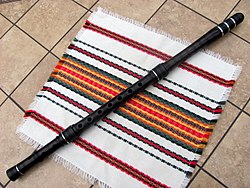
Back Кавал Bulgarian Qaval CRH Kaval German Kaval Finnish Kaval French Kaval Frisian קאוואל HE Kaval Croatian Բլուլ Armenian Kaval ID
This article needs additional citations for verification. (August 2019) |
 Bulgarian kaval in key of D (Re), African blackwood, made in 2012 by master craftsman Radoslav Paskalev | |
| Woodwind instrument | |
|---|---|
| Classification | Woodwind, Wind, Aerophone |
| Related instruments | |
| Çığırtma, Dilli Kaval, Duduk, Flute, Frula, Kawala, Jedinka, Ney, Shvi, Sring | |


The kaval is a chromatic end-blown oblique flute traditionally played throughout the Balkans (in Albania, Romania, Bulgaria, Southern Serbia, Kosovo, North Macedonia, Northern Greece, and elsewhere)[1] and Anatolia (including Turkey and Armenia).[2][3] The kaval is primarily associated with mountain shepherds.[1]
Unlike the transverse flute, the kaval is fully open at both ends, and is played by blowing on the sharpened edge of one end. The kaval has eight playing holes (seven in front and one in the back for the thumb) and usually four more unfingered intonation holes near the bottom of the kaval. As a wooden rim-blown flute, kaval is similar to the kawala of the Arab world and ney of the Middle East.
- ^ a b Rechberger, Herman (2018). Balkania: Rhythms in Songs and Dances From Albania, Bulgaria, The Republic of Macedonia, Romania and Serbia. Fennica Gehrman Ltd. p. 136. ISBN 9789525489279. Retrieved 3 August 2019.
- ^ Courroy, Isabelle. "La famille des flûtes kaval". kaval.org. Retrieved 3 August 2019.
- ^ Jeremy Montagu (29 October 2007). Origins and Development of Musical Instruments. Scarecrow Press. pp. 47–. ISBN 978-0-8108-7770-2.